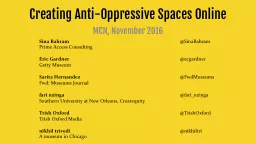

Online MCN November 2016 Sina Bahram SinaBahram Prime Access Consulting Eric Gardner ecgardner Getty Museum Sarita Hernandez FwdMuseums Fwd Museums Journal ID: 551704
Download Presentation The PPT/PDF document "Creating Anti-Oppressive Spaces" is the property of its rightful owner. Permission is granted to download and print the materials on this web site for personal, non-commercial use only, and to display it on your personal computer provided you do not modify the materials and that you retain all copyright notices contained in the materials. By downloading content from our website, you accept the terms of this agreement.
Slide1
Creating Anti-Oppressive Spaces Online
MCN, November 2016
Sina
Bahram
@
SinaBahram
Prime Access Consulting
Eric
Gardner
@
ecgardner
Getty Museum
Sarita
Hernandez
@
FwdMuseums
Fwd
: Museums Journal
fari
nzinga
@
fari_nzinga
Southern University at New
Orleans,
Createquity
Trish
Oxford
@
TrishOxford
Trish Oxford Media
nikhil
trivedi
@
nikhiltri
A
museum
in
ChicagoSlide2
Definitions
Anti-oppression: an approach to work that focuses on ending oppressions.
Creating Anti-Oppressive Spaces Online, MCN 2016Slide3
Equality vs. Equity
Creating Anti-Oppressive Spaces Online, MCN 2016Slide4
Equality vs. Equity vs. Reality vs. Liberation
Creating Anti-Oppressive Spaces Online, MCN 2016Slide5
Definitions
Intersectionality: a theory that examines how various categories of identity such as gender, race, class, ability, sexual orientation, religion, caste, age, nationality and others interact on multiple and often simultaneous levels.
Creating Anti-Oppressive Spaces Online, MCN 2016Slide6
Common Myths
“Those people” don't come to museums.
Creating Anti-Oppressive Spaces Online, MCN 2016Slide7
Common Myths
Everyone feels welcome at museums and is motivated to visit.
Creating Anti-Oppressive Spaces Online, MCN 2016Slide8
Common Myths
Museums are neutral authorities.
Creating Anti-Oppressive Spaces Online, MCN 2016Slide9
Common Myths
White people have the most to contribute, and have contributed the the most to the art world.
Creating Anti-Oppressive Spaces Online, MCN 2016Slide10
Are your sign-up forms respectful of people outside the norms of names, gender, sexuality, relationships and ethnicity?
Creating Anti-Oppressive Spaces Online, MCN 2016
Checklist
Collect all
user
data in changeable, free-form text fieldsSlide11
What data are you collecting? Why
are you collecting each piece of data? Is
your intention conveyed to users?
Does
the project respect the privacy of users?
Creating Anti-Oppressive Spaces Online, MCN 2016
Checklist
Be clear on why
you're
collecting each piece of data and what
you’re
doing with it Slide12
If you collect comments that will be made public, do you have guidelines for discourse in place?
Creating Anti-Oppressive Spaces Online, MCN 2016
Checklist
Establish guidelines for discourse onlineSlide13
Checklist
Creating Anti-Oppressive Spaces Online, MCN 2016
Do icons, photos, etc. assume things about gender, race or ability of users?
Use non-gendered, raced, or abled user icons Slide14
Checklist
Creating Anti-Oppressive Spaces Online, MCN 2016
Have you staged any photos that inaccurately reflect the diversity of your
visitorship
or staff?
Don't stage false diverse photographsSlide15
Have you been sure not to make business decisions based solely on existing analytics? Do you have a clear plan on how to measure the business decisions you've made, through analytics or otherwise?
Creating Anti-Oppressive Spaces Online, MCN 2016
Checklist
When using analytics: Decide, then act, then measure. Don’t measure, then decide, then act Slide16
What modes of communication do your teams use? Is that working for everyone?
Creating Anti-Oppressive Spaces Online, MCN 2016
Checklist
Consider and critique modes of communication: face-to-face, e-mailSlide17
Is the project accessible to older people, younger people, people without disabilities, and people with disabilities?
Creating Anti-Oppressive Spaces Online, MCN 2016
Checklist
Implement Universal Design and LearningSlide18
Is all the writing, including curatorial content, at an accessible reading level?
Creating Anti-Oppressive Spaces Online, MCN 2016
Checklist
Check the readability grade level of your textSlide19
Who’s not part of your design process? Why?
Creating Anti-Oppressive Spaces Online, MCN 2016
ChecklistSlide20
Create relationships and co-create with people of color
Creating Anti-Oppressive Spaces Online, MCN 2016
IdeasSlide21
Find out how to connect your work with movements
Creating Anti-Oppressive Spaces Online, MCN 2016
IdeasSlide22
Create work based on the needs of people
Creating Anti-Oppressive Spaces Online, MCN 2016
IdeasSlide23
Identify reusable wins
Creating Anti-Oppressive Spaces Online, MCN 2016
IdeasSlide24
Use money to subsidize programming
Creating Anti-Oppressive Spaces Online, MCN 2016
IdeasSlide25
Critique your organization’s inclusion work
Creating Anti-Oppressive Spaces Online, MCN 2016
IdeasSlide26
Share relevant articles about pressing issues
Creating Anti-Oppressive Spaces Online, MCN 2016
IdeasSlide27
Thanks!
Sina
Bahram
@
SinaBahram
Prime Access Consulting
Eric
Gardner
@
ecgardner
Getty Museum
Sarita
Hernandez
@
FwdMuseums
Fwd
: Museums Journal
fari
nzinga
@
fari_nzinga
Southern University at New
Orleans,
Createquity
Trish
Oxford
@
TrishOxford
Trish Oxford Media
nikhil
trivedi
@
nikhiltri
A
museum
in
Chicago
Creating Anti-Oppressive Spaces Online, MCN 2016